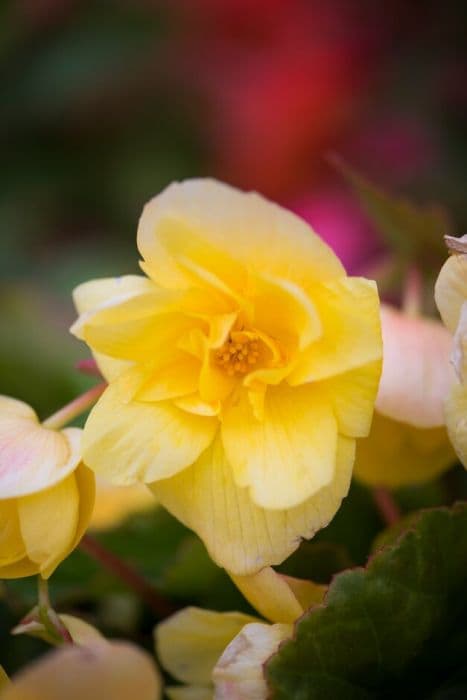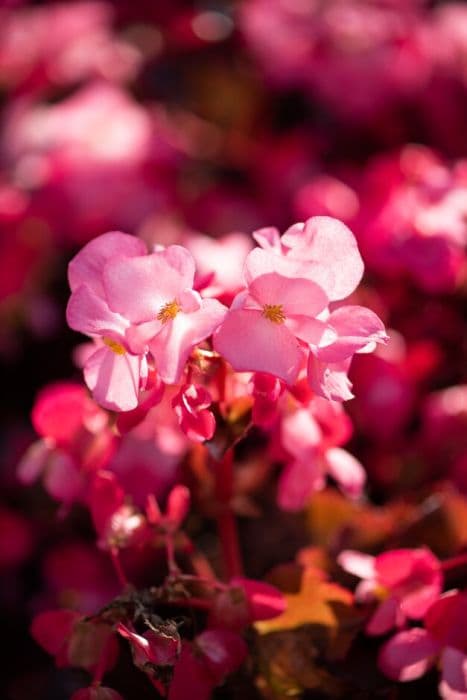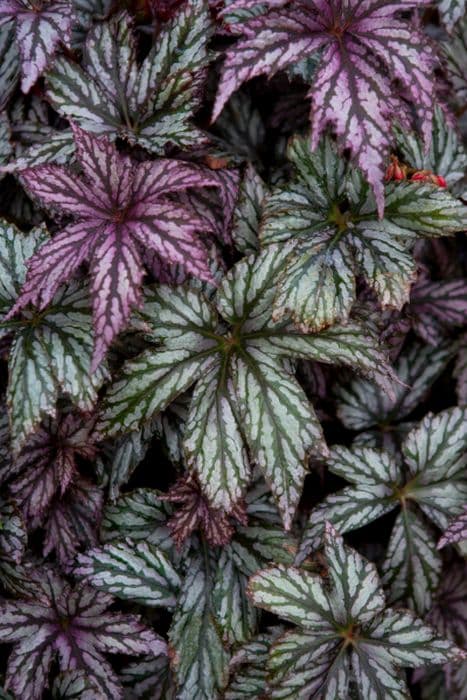Comte de Lesseps Begonia Begonia 'Comte de Lesseps' (C)

ABOUT
Begonia 'Comte de Lesseps' is a variety of begonias known for its ornamental foliage and flowers. The plant showcases broad, asymmetrical leaves with a distinctive green color. Each leaf typically has a unique pattern that may include various shades of green, often with a silvery or pale green sheen. The textures of the leaves can be quite elaborate, with some displaying a puckered or quilted surface, adding to their visual interest. The leaves of this variety sometimes have red or maroon undersides, which contrast beautifully with the lighter topside. Edges of the leaves can be either smooth or slightly toothed, lending a bit of edge to their overall soft appearance. The veins on the leaves are pronounced and may appear a different color, often a darker green, which can make the intricate patterns more noticeable. Flowering in Begonia 'Comte de Lesseps' typically occurs in the proper growing conditions, where clusters of delicate flowers bloom on the plant. These flowers are usually small and vary in color, often found in pale pink, white, or red tones. They dangle gracefully from the stems, adding a touch of elegance to the plant. Overall, Begonia 'Comte de Lesseps' has a lush and full appearance, with a blend of unique foliage and understated blossoms contributing to its appeal as a decorative houseplant or shade garden specimen. The plant's combined features of large, patterned leaves, contrasting colors, and textured foliage make it a statement piece in any plant collection.
About this plant
 Names
NamesFamily
Begoniaceae
Synonyms
Comte de Lesseps Begonia, King Begonia
Common names
Begonia 'Comte de Lesseps'.
 Toxicity
ToxicityTo humans
The Begonia, including Begonia 'Comte de Lesseps', can be toxic to humans if ingested. The plant contains compounds called oxalates, which can cause irritation of the mouth, lips, throat, and tongue. Symptoms of begonia poisoning can include a burning sensation in the mouth, excessive drooling, difficulty swallowing, and in severe cases, vomiting. It is recommended to keep the plant out of reach of children and to avoid ingesting any part of the plant.
To pets
The Begonia, including Begonia 'Comte de Lesseps', is also toxic to pets such as dogs and cats. Similar to its effects in humans, the ingestion of begonias can lead to oral irritation, drooling, vomiting, and difficulty swallowing due to the presence of insoluble oxalates. If a pet ingests part of a begonia plant, it may exhibit signs of distress or discomfort, and in such cases, it is advised to contact a veterinarian immediately. It is important to keep the plant away from pets to prevent accidental ingestion.
 Characteristics
CharacteristicsLife cycle
Perennials
Foliage type
Evergreen
Color of leaves
Mixed
Flower color
Pink
Height
1-2 feet (0.3-0.6 meters)
Spread
1-2 feet (0.3-0.6 meters)
Plant type
Herb
Hardiness zones
10
Native area
Tropical Asia
Benefits
 General Benefits
General Benefits- Ornamental Appeal: Adds beauty to home and garden with its lush foliage and attractive flowers.
- Enhances Mood: Increases well-being by adding nature and aesthetic value to living spaces.
- Humidity Regulation: Helps maintain a balanced indoor humidity level through transpiration.
- Shade Tolerance: Thrives in lower light conditions making it suitable for indoor environments.
- Easy Propagation: Can be easily propagated from leaf cuttings, allowing for more plants to be grown.
- Low Maintenance: Requires minimal care, making it ideal for beginners or those with little time.
- Long Blooming Period: Produces flowers for an extended period, providing long-lasting color and interest.
 Medical Properties
Medical PropertiesThis plant is not used for medical purposes.
 Air-purifying Qualities
Air-purifying QualitiesThis plant is not specifically known for air purifying qualities.
 Other Uses
Other Uses- Decorative motifs: Leaves of the Begonia 'Comte de Lesseps' can be used as patterns or designs for textiles, wallpaper, or other interior design elements, thanks to their unique shapes and colors.
- Photography subject: Its striking foliage and flowers make it an appealing subject for botanical photographers and plant enthusiasts looking to enhance their portfolios.
- Arts and crafts: The leaves and flowers can be pressed and used in crafting activities, such as creating personalized greeting cards or bookmarks.
- Culinary presentation: Although not commonly consumed, the vibrant leaves can be used as a natural garnish for exotic dishes, adding a pop of color to culinary presentations.
- Learning tool: The Begonia 'Comte de Lesseps' can be used in educational settings to teach about plant care, propagation, and hybridization techniques to students and gardening enthusiasts.
- Cultural ceremonies: In some cultures, decorative plants like Begonia 'Comte de Lesseps' are used to adorn spaces during festivals or celebrations, symbolizing growth and beauty.
- Plant shaping: Its growth pattern allows enthusiasts to train and shape it into artistic forms, such as topiaries or living sculptures, for ornamental purposes.
- Eco-friendly packaging: Dried leaves from the plant may serve as eco-friendly and biodegradable wrappers for small items, reducing the reliance on plastics.
- Color inspiration: The Begonia's varied hues can inspire artists and designers for paint colors, fashion ensembles, or home décor palettes.
- Themed events: Its distinct appearance can contribute to the decor of garden-themed parties, weddings, or other events where natural beauty is a key element.
Interesting Facts
 Feng Shui
Feng ShuiBegonia is not used in Feng Shui practice.
 Zodiac Sign Compitability
Zodiac Sign CompitabilityBegonia is not used in astrology practice.
 Plant Symbolism
Plant Symbolism- Caution: Begonia symbolism often carries a message of caution or warning. The 'Comte de Lesseps' Begonia, with its lush foliage, might be seen as a reminder to proceed carefully in new situations or relationships.
- Harmony: The balanced and symmetrical leaf patterns of the Begonia can symbolize balance and harmony in one's life, suggesting the importance of a stable environment.
- Friendship: Giving a Begonia, like the 'Comte de Lesseps', can be a way of expressing care and friendship due to its amiable and pleasing appearance.
- Individuality: With its striking and unique patterns, Begonias can represent individuality and the celebration of one's uniqueness.
- Gratitude: The Begonia is also associated with gratitude and appreciation, possibly because of its long-lasting nature and the pleasure it brings to those who care for it.
 Water
WaterWater Begonia 'Comte de Lesseps', commonly known as King Begonia, deeply until water flows freely from the drainage holes, then allow the top inch of soil to dry out before watering again. Typically, this plant requires watering approximately once a week, but this can vary depending on environmental conditions such as temperature and humidity. Adjust the frequency to accommodate seasonal changes, watering less in winter and more in summer. Provide roughly 16 to 24 ounces of water per week during the active growing season, and reduce the amount during dormancy.
 Light
LightKing Begonia thrives in bright, indirect light but must be shielded from direct sunlight, which can scorch the leaves. A north-facing or east-facing window where the plant receives morning light or dappled sunlight throughout the day is ideal. If you only have a south or west-facing window, use a sheer curtain to diffuse the strong sunlight.
 Temperature
TemperatureKing Begonia prefers temperatures between 60 and 70 degrees Fahrenheit for optimal growth. They can tolerate a range down to 50 degrees Fahrenheit but should not be subjected to temperatures below 50 degrees Fahrenheit as cold temperatures can damage the plant. Avoid placing your Begonia in areas with cold drafts or extreme temperature fluctuations for the best results.
 Pruning
PruningPrune King Begonia to maintain its shape, remove any dead or yellowing leaves, and promote healthier, bushier growth. The best time to prune is in the spring, as the plant exits dormancy. You can prune every few months or as needed to remove old flowers or leaves, but be gentle to avoid stressing the plant.
 Cleaning
CleaningAs needed
 Soil
SoilThe best soil mix for Begonia 'Comte de Lesseps' is a well-draining, light, and airy mix, such as one part peat moss, one part perlite, and one part pine bark fines. Adjustments or the addition of coir or loam can enhance the mix's properties. The ideal soil pH for this begonia should be slightly acidic to neutral, ranging between 5.5 and 7.0.
 Repotting
RepottingBegonias generally need to be repotted every 1-2 years to replenish the soil and accommodate root growth. For the Begonia 'Comte de Lesseps', repotting every spring is ideal, as long as the plant shows signs of outgrowing its current pot or if the soil seems depleted.
 Humidity & Misting
Humidity & MistingBegonia 'Comte de Lesseps' thrives in high humidity conditions, ideally between 50% and 70%. Maintaining this range will support vigorous growth and healthy foliage. It's beneficial to use a pebble tray or humidifier if inside air is dry.
 Suitable locations
Suitable locationsIndoor
Place in bright, indirect light, keep soil moist but not waterlogged.
Outdoor
Provide dappled sunlight, shelter from wind, and monitor soil moisture.
Hardiness zone
10-11 USDA
 Life cycle
Life cycleThe life of a Begonia 'Comte de Lesseps', commonly known as King Begonia, begins with seed germination, where the tiny seeds require light, warmth, and moisture to sprout. After germination, the seedlings grow into juvenile plants, developing their characteristic asymmetrical leaves and starting to form a bushy structure. As the plant matures, it continues to produce larger leaves with a distinct pattern and may produce clusters of subtle flowers if provided with the right conditions. King Begonia reaches full maturity in a couple of years, given optimal growing conditions which include well-drained soil, indirect light, and high humidity. This plant can be propagated through leaf cuttings or division, which initiates a new life cycle. Eventually, King Begonia may experience a decline in vigor, typically due to age or unsuitable conditions, which may lead to dormancy or the end of its life cycle.
 Propogation
PropogationPropogation time
Spring-early summer
Begonia 'Comte de Lesseps', often referred to simply as Begonia, is commonly propagated through leaf cuttings, a popular method for many in the begonia family. The most favorable time for propagation is during the warmer months of spring and summer when the plant is actively growing. To propagate from a leaf cutting, a healthy, mature leaf is chosen and the main veins are sliced on the underside, then the leaf is placed vein-side down onto a moist potting mix. Alternatively, the leaf may be cut into wedges with at least one vein intersection per piece, which are then pressed into the potting medium. These cuttings should be kept under high humidity, for instance, by covering them with a plastic bag or placing them in a propagator. Roots usually develop within a few weeks, at which point the new plants can be transferred to individual pots. It's important to keep the soil mildly moist but not waterlogged to prevent rot.




![Begonia [Devotion]](/_next/image?url=https%3A%2F%2Fplants-admin.emdemapps.com%2Fimages%2Fplants%2F%2Fimages%2F604b58183573b.png&w=640&q=75)




